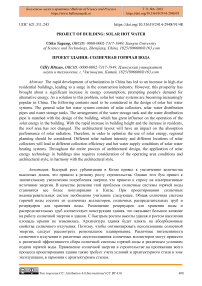Project of building: solar hot water
Автор: Shu Yugang
Журнал: Бюллетень науки и практики @bulletennauki
Рубрика: Технические науки
Статья в выпуске: 6 т.9, 2023 года.
Бесплатный доступ
The rapid development of urbanization in China has led to an increase in high-rise residential buildings, leading to a surge in the construction industry. However, this prosperity has brought about a significant increase in energy consumption, prompting people's demand for alternative energy. As a solution to this problem, solar hot water systems are becoming increasingly popular in China. The following contents need to be considered in the design of solar hot water systems. The general solar hot water system consists of solar collectors, solar water distribution pipes and water storage tanks. The arrangement of the water storage tank and the water distribution pipe is matched with the design of the building, which has great influence on the operation of the solar energy in the building. With the rapid increase in building height and the increase in residents, the roof area has not changed. The architectural layout will have an impact on the absorption performance of solar radiation. Therefore, in order to optimize the use of solar energy, regional planning should be considered. Different solar radiant intensity and different locations of solar collectors will lead to different collection efficiency and hot water supply conditions of solar water heating systems. Throughout the entire process of architectural design, the application of solar energy technology in buildings also requires consideration of the operating area conditions and architectural style, in harmony with the architectural style.
Solar hot water engineering, building, solar collector
Короткий адрес: https://sciup.org/14127999
IDR: 14127999 | УДК: 621.311.243 | DOI: 10.33619/2414-2948/91/48
Текст научной статьи Project of building: solar hot water
Бюллетень науки и практики / Bulletin of Science and Practice
Since the 1970s, the worldwide energy crisis has led to the world's attention to energy conservation and the development and utilization of renewable energy [1]. Under the pressure of increasing tension of conventional energy and increasing environmental pollution, most countries have accelerated the pace of development and utilization of new energy. As a clean and renewable energy, solar energy has become the focus of international development and utilization. This has also promoted the rapid development of solar energy heat utilization, especially solar energy technology [2].
In the process of using solar energy, people use solar water heating system to provide domestic hot water, which can greatly save energy costs and reduce the living expenses of residents. Solar water heating system has many advantages and is popular with the public. In China, with the transfer of rural population to the city, a large number of rural people have poured into the city, and the urban population has increased in a large number. Urban residential buildings are also developing in the direction of high-rise residential buildings. High-rise residential buildings will become the main application field of solar hot water projects. Solving the problem of compatibility between solar water heating system and building structure is the future development direction [3].
In the process of human development, the use of these conventional energy sources has limitations. The use of renewable energy poses great harm to the environment, and people are facing these numerous threats and challenges, which has prompted more and more attention to renewable energy [4]. We all know that solar energy is inexhaustible and is also a pollution-free renewable energy source. It is also primary energy. Solar energy resources are very abundant, pollution-free, and do not require transportation, which can be directly obtained locally. Vigorously promoting solar energy technology is of great significance for improving the environment and improving residents' living standards.
This article mainly introduces the solar hot water system, providing a detailed introduction to the collector, system operation mode, heat transfer type, and selection of solar hot water system.
Currently, the main products of solar collectors in the domestic market in China include flat panel collectors, vacuum tube collectors, and heat pipe collectors [5].
(一) Flat plate collector
The components of a flat plate type heat collector include : There are four parts: heat absorbing plate, cover plate, insulation layer, and shell. Due to its simple manufacturing, reliable operation, and low cost, it has been widely used. Is the most commonly used type of heat collector in Europe, accounting for 35% of the total global stock of solar water heaters in 2004 [6].
In the 1980s, the usage accounted for the vast majority of the domestic market, but in the past decade, the market share has been declining year by year, with fewer usage. The temperature of hot water for preparation is about 30~70oC[7], Mainly used for domestic hot water preparation and building heating. Advantages: It can operate under pressure and can be combined with buildings in various ways. Disadvantages: In low temperature environments, the surface has significant heat loss and low heat collection efficiency.
-
( 二 ) Vacuum tube collector
The vacuum tube is composed of two layers of glass tubes, and the interlayer is evacuated to prevent heat from conducting to the outside (Figure 1). The different structures and heat transfer modes within vacuum tubes can be divided into three types: all glass vacuum tube collectors, U-tube collectors, and heat pipe vacuum tube collectors. The use of vacuum tube heat collectors in China accounts for more than 90%, mainly using all glass vacuum tubes. The vacuum tube heat collector can produce hot water of about 80~180T, with a maximum water temperature of over 200T [8], It can operate under pressure and efficiently in low-temperature environments, so it can be used for domestic and industrial hot water preparation.
All glass vacuum tube heat collector: After sunlight passes through the outer glass of the allglass vacuum tube heat collector, it irradiates the inner tube surface coated with a selective absorption film, converting it into heat energy, and then directly heating the heat transfer medium flowing in the glass tube. Its characteristic is high operating efficiency, but its disadvantage is that it cannot operate under pressure, is prone to cracking and scaling. U-tube vacuum tube collector: U-shaped tubes (usually copper tubes) with metal fins coated with selective coatings on the welded surface inside a vacuum glass tube. After being sealed and combined with glass melting seal or insulation plug, the pipe is led to the outside of the heat collector as the inlet and outlet of its heat transfer working medium (Figure 2).
The main components of a heat pipe type vacuum tube collector include: heat pipe, vacuum pipe, and heat absorbing plate. The solar heat absorbed by the heat collector through the heat absorbing plate is vaporized in the heat pipe, and the working medium is vaporized and rises to the condensing end of the heat pipe for condensation. The working medium is condensed into a liquid, releasing the latent heat of vaporization, and heating the water in the water tank. The working medium then flows to the lower end of the heat pipe under the action of gravity. This is repeated. The advantage of heat pipe type vacuum tube heat collector lies in its strong frost resistance (Figure 3).
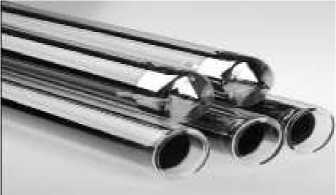
Figure 1. All glass collector details
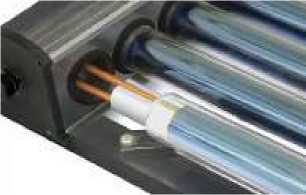
Figure 2. Internal structure diagram of U-shaped
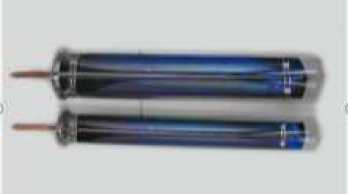
Figure 3. Heat pipe vacuum pipe collector mechanism
pipe
-
( 三 ) Heat pipe solar water heater
Heat pipe type collectors can be divided into heat pipe type vacuum pipe collectors and heat pipe type flat plate collectors, and their heat collection principles are basically the same. The heat pipe type vacuum tube heat collector can also be considered as a type of vacuum tube heat collector. The heat pipe heat collector is a component that does not require movement and external power. The liquid working medium in its pipe has antifreeze and anti backflow characteristics, and can be used in cloudy and windy cold areas. There is also a type of solar collector that is widely used abroad, which is a solar collector without a cover plate. It can prepare warm water at around 30℃, mainly used for heating swimming pool water, preheating car washing water, and so on. It is almost not used in China. Brief classification table of the following type heat collectors (Table).
Table
CLASSIFICATION AND CHARACTERISTICS OF SOLAR COLLECTORS
|
Type of collector |
Characteristic |
Installation and usage characteristics |
|
Flat type |
Metal or metal plate absorbs heat Plate and frame structure |
Easy to combine with buildings, can be installed in a large area, and has a long service life, but poor antifreeze ability in winter |
|
All glass |
Double glass tube |
The glass tube and the header are |
|
g |
Water is directly heated in the inner glass |
connected in a straight plug manner, |
|
tube |
which has low cost, high efficiency, but poor stability |
|
|
з heat pipe s ;> |
The glass tube is equipped with a metal heat |
High efficiency, easy to install in a large |
|
absorbing plate |
area, with good frost resistance, but |
|
|
The fluid is heated by the condensation end of the heat pipe and does not flow through the heat collector pipe |
high cost |
|
|
Glass |
The glass tube is equipped with a metal tube |
High efficiency, easy to install in a large |
|
vacuum -metal tube |
The fluid is heated in a metal tube |
area, good antifreeze performance, stable performance, but high cost |
The operation modes of solar hot water systems include natural circulation, direct flow system, and forced circulation.
-
(1) Natural circulation system. Natural circulation systems are also known as thermal siphon systems. The circulation between the collector and the system is realized by using only the density change of the medium. The system has a simple structure and does not require auxiliary power. However, in order to ensure the necessary thermal siphon pressure head of the system, the location of the water storage tank must be higher than the heat collector when installed (the bottom of the tank should be 0.3~0.5m higher than the heat collector). This method of installing water tanks may have certain limitations when combined with buildings (Figure 4).
-
(2) Direct system. The heat transfer working medium flows through the heat collector once for heating, and then enters the noncirculating solar water heating system at the water storage tank or water consuming place. Suitable for use in places with certain water temperature requirements and the requirement to use up all available hot water within the specified water usage period.
(3) Forced circulation system. Forced circulation is also known as active circulation solar water heating system, which uses a pump or fan to force heat transfer working fluid through a heat collector to circulate. This system has no special requirements for the placement of heat collectors and water storage tanks. Its layout is relatively flexible and suitable for building integration (Figure 5).

Figure 4. Solar natural circulation system
Figure 5. Forced circulation
There are two types of heat transfer for solar hot water systems: direct systems and indirect systems.
Direct system. It is also known as a single loop system or a single cycle system. It operates by heating cold water in a heat collector and flowing into a water storage tank, where the prepared hot water is then directly delivered to the user. Its advantages are low investment and high system efficiency. The disadvantage is that it is difficult to ensure water hygiene and easy to scale. When used in cold regions in winter, methods such as emptying should be used to prevent freezing of water pipes (Figure 6).
Indirect system. Indirect systems are also known as dual loop systems and dual cycle systems. The heat transfer medium is heated in a solar collector, and then used to flow through a heat exchanger, before the heated hot water is supplied to the user. This method transfers heat, and the user's water does not participate in the cycle, so it can ensure the quality of water used. Heat transfer working medium can be added with antifreeze to prevent water pipes from freezing and cracking (Figure 7).
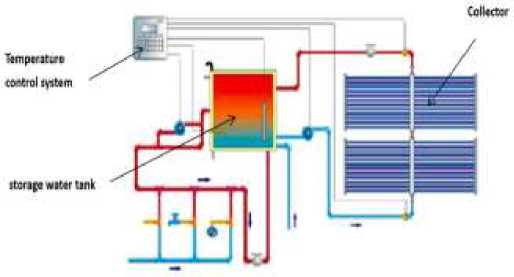
Figure 6. Direct System
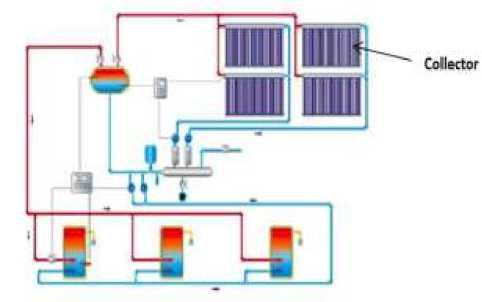
Figure 7. Indirect System
According to the requirements of this project, the selected heat collector is a heat pipe vacuum tube heat collector, which is suitable for local climatic conditions and can operate stably in the local area. The operation mode of the system is 24-hour operation, which can supply hot water all day to meet the hot water demand. According to Appendix 3, the forced circulation system can be selected for this hotel building, which requires a circulating water pump; The system also requires a water storage tank to store hot water; An auxiliary heating system is required, and electric heating is used for auxiliary heating.
The energy required for the solar hot water system is not traditional fossil energy. It only needs to consume solar energy to operate the system. Solar energy is a very clean energy source, and its acquisition is very simple, without the need for transportation like conventional energy. It can be obtained locally at any time and is free of charge. Using a solar hot water system to prepare hot water is not only clean and environmentally friendly, but also saves resources and reduces the cost of preparing hot water. In order to achieve the expected requirements of the solar hot water system, it is necessary to reduce investment costs and achieve high economic efficiency and strong feasibility. This requires us to design a better solar hot water system.
Conclusions
China is rich in coal as fuel resource storage, but its per capita possession is relatively low. Thermal power generation is still the main form of electricity production, with coal accounting for over 80% of power generation, and the amount of coal consumed for power generation accounts for over 50% of the country's coal production [9].
China is very rich in solar energy resources, with an annual average sunshine duration of more than 2200 h/a, and the total annual solar irradiance in areas accounting for more than 66.7% of China's land area is higher than 5016 MJ/m2 [10]. China is rich in solar energy resources, which provides a resource base for the development of solar water heaters.
Using solar energy in buildings is the future development direction, and energy conservation is the theme of future building development [11], Deepening solar energy utilization is one of the effective ways to solve the problem of high energy consumption in buildings and save energy [12]. Conventional water heaters have the disadvantage of high energy consumption [13], Using solar water heaters can effectively reduce the peak load of electric power transportation, as well as reduce the consumption of coal, oil, natural gas, and other fuels. Developing and utilizing high-quality solar water heaters is the theme of development [14].
Список литературы Project of building: solar hot water
- Green Building Research Center of Xi'an University of Architecture and Technology (1999). Green building, China Planning Press, Beijing, 16-20.
- Xu, Liang, Zhu, Chunjin, & Wang, Lin (2011). Design of the solar hot water project for the Yellow River Building. Shanxi, Huangming Solar Energy Co, 13-16.
- Yang, Jinliang (2008). Design of solar hot water system for mid to high rise residential buildings. Building Technology, 100-103.
- Engelberg, Fragg (2003). Architecture + Technology. Beijing: China Construction Industry Press, (17), 150-155.
- Zhou, Ruoqi (1999). Green Building. China Planning Press, 23-24.
- Cai, Junfu (1991). Residential energy-saving design. China Construction Industry Press, 32-35.
- Liu, Nianxiong, & Qin, Ruoguo (2005): Architectural Thermal Environment. 33-37.
- Wang, Shouzhi (2003). World History of Modern Architecture, China Industrial Press, 17-19.
- Qian, Bozhang (2008). Energy conservation and emission reduction - the only way to sustainable development. Beijing: Science Press, 78-82.
- Hu, Runqing, & Li, Junfeng (2007). The Development Status and Enlightenment of Global Solar Water Heater Industry and Technology. Solar Energy, 2, 8-11.
- Jiang, Yi. (2007). Building Energy Efficiency and Lifestyle. Journal of Architecture, 12, 11-15.
- Yang, Lingyan, Ni, Long, & Yao, Yang (2009). Operation mode of integrated system of energy storage solar energy and air source heat pump. Gas and Heat, 29(1), A01-A04.
- Luo, Qinghai, Tang, Guangfa, & Gong, Guangcai (2004). Heat Pump Technology in Building Hot Water Energy Conservation. Water supply and drainage, (5), 63 -66.
- Bewersdorff, H W. (2003) Year round performing and potential of a nature circulation type of solar water heater in India. Energy and buildings, (3), 239-247.

